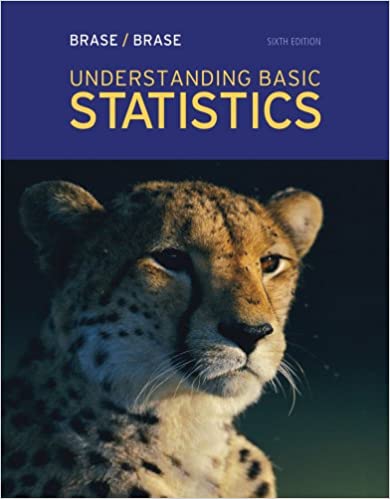
Understanding Basic Statistics 6th Edition by Charles Henry Brase,Corrinne Pellillo Brase
Edition 6ISBN: 978-1111827021
Understanding Basic Statistics 6th Edition by Charles Henry Brase,Corrinne Pellillo Brase
Edition 6ISBN: 978-1111827021 Exercise 17
Use the following steps (i)-(v) for all hypothesis tests:
(i) What is the level of significance State the null and alternate hypotheses.
(ii) Check Requirements What sampling distribution will you use What assumptions are you making What is the value of the sample test statistic
(iii) Find (or estimate) the P -value. Sketch the sampling distribution and show the area corresponding to the P -value.
(iv) Based on your answers in parts (i)-(iii), will you reject or fail to reject the null hypothesis Are the data statistically significant at level a
(v) Interpret your conclusion in the context of the application.
Note: For degrees of freedom d.f. not in the Student's t table, use the closest d.f. that is smaller. In some situations, this choice of d.f. may increase the P -value a small amount and thereby produce a slightly more "conservative" answer.
Testing and Estimating µ with known Let x be a random variable that represents micrograms of lead per liter of water ( µ g/L). An industrial plant discharges water into a creek. The Environmental Protection Agency has studied the discharged water and found x to have a normal distribution, with = 0.7 µ g/L (Reference: EPA Wetlands Case Studies).
(a) The industrial plant says that the population mean value of x is µ = 2.0 µ g/L. However, a random sample of n =10 water samples showed that
 = 2.56 µ g/L. Does this indicate that the lead-connection population mean is higher than the industrial plant claims Use = 1%.
= 2.56 µ g/L. Does this indicate that the lead-connection population mean is higher than the industrial plant claims Use = 1%.
(b) Find a 95% confidence interval for µ using the sample data and the EPA value for .
(c) How larger a sample should be taken to be 95% confident that the sample mean
 is within a margin of error E = 0.2 µ g/L of the population mean
is within a margin of error E = 0.2 µ g/L of the population mean
(i) What is the level of significance State the null and alternate hypotheses.
(ii) Check Requirements What sampling distribution will you use What assumptions are you making What is the value of the sample test statistic
(iii) Find (or estimate) the P -value. Sketch the sampling distribution and show the area corresponding to the P -value.
(iv) Based on your answers in parts (i)-(iii), will you reject or fail to reject the null hypothesis Are the data statistically significant at level a
(v) Interpret your conclusion in the context of the application.
Note: For degrees of freedom d.f. not in the Student's t table, use the closest d.f. that is smaller. In some situations, this choice of d.f. may increase the P -value a small amount and thereby produce a slightly more "conservative" answer.
Testing and Estimating µ with known Let x be a random variable that represents micrograms of lead per liter of water ( µ g/L). An industrial plant discharges water into a creek. The Environmental Protection Agency has studied the discharged water and found x to have a normal distribution, with = 0.7 µ g/L (Reference: EPA Wetlands Case Studies).
(a) The industrial plant says that the population mean value of x is µ = 2.0 µ g/L. However, a random sample of n =10 water samples showed that
 = 2.56 µ g/L. Does this indicate that the lead-connection population mean is higher than the industrial plant claims Use = 1%.
= 2.56 µ g/L. Does this indicate that the lead-connection population mean is higher than the industrial plant claims Use = 1%.(b) Find a 95% confidence interval for µ using the sample data and the EPA value for .
(c) How larger a sample should be taken to be 95% confident that the sample mean
 is within a margin of error E = 0.2 µ g/L of the population mean
is within a margin of error E = 0.2 µ g/L of the population meanExplanation
(a) We are to perform a hypothesis test ...
Understanding Basic Statistics 6th Edition by Charles Henry Brase,Corrinne Pellillo Brase
Why don’t you like this exercise?
Other Minimum 8 character and maximum 255 character
Character 255


